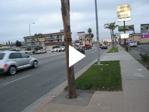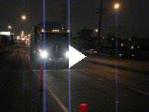Below is my first monthlty update. If you sign up for the email list, you will get an email like this once a month. Some of it is repeated material from the rest of the journals.
Welcome to the first official mass email of A Ride for the Climate. These once-a-month updates are for your enjoyment. I provide all-caps headers below for a number of different topics. Feel free to read only the parts that interest you!
QUICK SUMMARY
I have biked over 800 miles now, arriving in San Diego via the cities of Monterey, Fresno, Ventura, and Los Angeles. I took a week off for Thanksgiving to be with family, and I have taken another week off in San Diego replacing a stolen passport See a map of my route at www.rideforclimate.com/now.php.
From the redwoods in the bay area to Monterey Bay to the dry hills between the ocean and the central valley to the friendly tractor drivers in the central valley (all of whom wave to cyclists) to the 6,000 ft mountains near Ventura to the Pacific coast from L.A. to San Diego, California continues to amaze me. For a slide show of this adventure-by-bike, click here . (You can increase the picture resolution with the button just above the pictures.)
YOU WENT TO FRESNO? THE CENTRAL VALLEY?
I biked to Fresno to make a statement — climate change is going to be bad for California’s central valley.
The central valley grows a majority of the United States’ fruits and nuts, and I enjoyed biking through seemingly endless fields of vineyards, orchards and other crops.
The strangest part of biking the central valley was the language — should I talk to people in Spanish or English? Mexican immigrants make up (I think) a majority of the population, and conversations were a mixture of Spanish and English, especially with the many friendly farm works I talked to while biking across the valley.
WHAT DOES GLOBAL WARMING MEAN FOR CALIFORNIA?
No, we are not all going to die (this is a common response from students). The biggest problems are going to be with our water system. The Sierra Nevada mountains store an incredible amount of water as snowpack during the winter, and then release the water as snow melt during the spring and summer. We are going to lose this snow pack, and water, which is so essential to the cities and agriculture of California, will be scarcer.
It is also likely going to get much warmer in the summer — between 4 and 15 degrees F. The lower estimate assumes we are good about reducing carbon dioxide emissions this century. The higher estimate assumes that we keep doing what we are doing. It is not hard to see that 15 degrees warmer in the central valley during the summer will be bad — it is already hot, and agriculture will likely suffer. Heat waves will be a problem, as well as increases in heat-related diseases. To read more about these findings, go to www.climatechoices.org .
SO DAVE, WHAT DO PEOPLE THINK ABOUT GLOBAL WARMING?
I have asked many people what they know about global warming. It is interesting that a large portion of the those I have talked to say ‘it is happening and it is bad.’ I think less then a quarter of the people I talked to said ‘I haven’t made up my mind yet,’ and a smaller percentage (notably a farmer I talked to in the Central Valley) told me it was all made up.
While people are aware of the problem, they don’t always equate their actions with the problem. The bus driver who talked for 5 minutes about global warming screwing up the world then talked about buying a large RV and driving it around the country. We need to better equate the problems of climate change with our individual actions.
CARS IN SOUTHERN CALIFORNIA
There are a lot of them. The short story: L.A. is the least bike friendly city I have ridden in. I have put together a photo essay of cars. To read about biking L.A. go here.
It is sad to see so many large cars on the road — SUVs and trucks use far more gas than sedans, and the single easiest way to reduce your global warming impact is to drive a smaller car. If you are looking to get a new car, I encourage you to try to get a more efficient one.
I understand why people want bigger cars — more space, higher off the ground, and, given the design of these cities, you will spend a lot of time in your car. These large cars, though, are not safer and also cost much more. If you want to drive a large car, I encourage you to consider buying carbon credits.
TAKE ACTION
Please consider signing the following on-line petitions:
www.undoit.org
If you are a student, I encourage you to consider joining the urally pledge:
www.urally.org
I also encourage you to consider ways you can use energy more efficiently- whether it is turning off the lights or taking the smaller car to the grocery store instead of the bigger one. It will save you money as well as help the Earth’s climate.
SCHOOL VISITS
I have visited 17 different schools now, talking to almost 1,000 students.. These visits have been immensely enjoyable, and I hope those of you students on this list learned something about the world from the visits. There are pictures of every school I visited here.
THANKS TO THE GENEROUS
Thanks to Kirsten and Tom, Luke and Heather for helping me out with meals, showers, and morale. Thanks to Heather (other Heather) for riding to Monterey with me, the Telles family for housing and feeding me, Anne Morningstar for housing and feeding me, Julia Goodnough for storing my bike and letting me crash at her place, and Sheila Walsh and her housemates Lauren and Milenia for letting me stay at their place an entire week (!) while I got a new passport. This support is the greatest way to be sponsored, and a trip like this reaffirms your belief in people.
DON’T LEAVE YOUR WALLET UNATTENDED
Well, not all people. I left my wallet on top of my bicycle for 5 minutes at a convenience store in Camp Pendleton Naval Base just north of San Diego. My wallet, with passport inside, was stolen, forcing me to spend this week in San Diego, waiting to get a new passport.
DO YOU HAVE YOUR PASSPORT NOW?
Yes! And now, I will now make a run for the border armed with a bicycle, four panniers, and my Spanish-English dictionary. Stay tuned!
This trip has barely begun, and there are so many more stories down the road. You will likely get an update of travels another 1,500 miles down the road, as I pass Mexico City.
David







